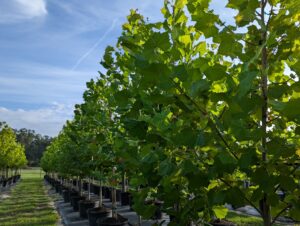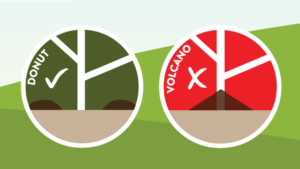
American Sycamore (Platanus occidentalis) is a relatively fast-growing tree. You can start to take advantage of it’s shady benefits in just a couple of years. Photo by Anna Stubbendick, Canterbury Farms
Don’t let the summer heat keep you down. Dive into the world of shade trees with us and explore how they can transform your yard into a cool and inviting oasis. Since our nursery is located in Pasco County, FL, we’ll be focusing on some of their residential yard requirements and highlighting some fantastic native Florida varieties that are perfect for creating a shady retreat. So, grab your gardening gloves and let’s get started!
The Importance of Shade Trees in Your Yard:
In the scorching Florida heat, shade trees are like your personal superheroes, providing relief from the sun’s relentless rays. They offer a multitude of benefits that go beyond just aesthetics. Shade trees can:
- Reduce energy costs: By strategically planting shade trees near your home, you can lower your energy bills by providing natural cooling and reducing the need for excessive air conditioning.
- Create a comfortable outdoor space: With the shade provided by these trees, you can create a cool and tranquil retreat where you can relax, entertain, and enjoy the beauty of nature.
- Improve air quality: Trees absorb carbon dioxide and release oxygen, helping to purify the air we breathe. They also act as natural filters, reducing dust, pollutants, and noise levels.
- Support wildlife: Native shade trees attract birds, butterflies, and other wildlife, enhancing biodiversity in your yard and promoting a healthy ecosystem.
Native Florida Shade Tree Varieties:
Let’s take a closer look at some fantastic native trees that thrive in our area, and qualify as approved shade trees for Pasco County. All of these trees are typically in stock at Canterbury Farms Nursery & Garden Center:
- Southern Live Oak (Quercus virginiana): A majestic, large evergreen tree with spreading branches and glossy dark green leaves. It provides dense shade and is known for its longevity and resilience.
- Red Maple (Acer rubrum): A deciduous tree that showcases vibrant red foliage in the fall. It has a rounded canopy and adds a splash of color to any landscape.
- American Sycamore (Platanus occidentalis): A massive deciduous tree with distinctive mottled bark and broad, palmate leaves. It offers ample shade and has an imposing presence.
- Sweetgum (Liquidambar styraciflua): A tall, deciduous tree with star-shaped leaves that turn brilliant shades of red, orange, and yellow in the fall. It provides a beautiful display of colors.
- Bald Cypress (Taxodium distichum): A deciduous conifer known for its unique, buttressed trunk and feathery foliage. It thrives in wet areas and offers a graceful, delicate appearance.
- Southern Magnolia – D.D. Blanchard and Little Gem cultivars (Magnolia grandiflora): Evergreen trees with large, glossy leaves and fragrant, showy white flowers. They provide year-round shade and a touch of elegance.
- Slash Pine (Pinus elliottii): A fast-growing evergreen tree with long needles and a straight trunk. It offers excellent shade and is commonly found in forests and large landscapes.
- Eastern Red Cedar (Juniperus virginiana): A compact evergreen tree with dense foliage and aromatic wood. It provides year-round shade and serves as a privacy screen.
- Elm – Winged, American (Ulmus alata, Ulmus americana): Deciduous trees with graceful arching branches and serrated leaves. They provide shade and exhibit a lovely form.
| Common Name | Botanical Name | Mature Size Range | Root Spread | Evergreen |
|---|---|---|---|---|
| Southern Live Oak | Quercus virginiana | 40-80 ft | 80-100 ft | Yes |
| Red Maple | Acer rubrum | 40-60 ft | 30-40 ft | No |
| American Sycamore | Platanus occidentalis | 70-100 ft | 50-70 ft | No |
| Sweetgum | Liquidambar styraciflua | 60-75 ft | 40-50 ft | No |
| Bald Cypress | Taxodium distichum | 50-70 ft | 30-40 ft | No |
| Southern Magnolia | Magnolia grandiflora | 20-40 ft | 30-40 ft | Yes |
| Slash Pine | Pinus elliottii | 60-100 ft | 40-60 ft | Yes |
| Eastern Red Cedar | Juniperus virginiana | 25-40 ft | 20-30 ft | Yes |
| Elm | Ulmus spp. | 40-80 ft | 40-60 ft | No |
Note: There are several other species of commonly used landscape trees that were formerly on Pasco County’s recommended tree list which are now considered “Ornamental Trees” instead of “Shade Trees.” These trees include Crape Myrtles, several Hollies, Bottlebrush, and Ligustrum, among others less commonly used.
Why Palm Trees Aren’t Generally Considered Shade Trees:
Palm trees are certainly iconic in Florida, but they are not typically considered shade trees. While they offer a tropical ambiance and are well-suited to coastal landscapes, their tall, slender trunks and sparse canopies provide limited shade. However, they can be great for accentuating certain areas of your yard or creating a focal point. There are only a few species of larger palms that are approved for use as shade trees in Pasco County as of July 2023, here’s a list of the varieties typically found at Canterbury Farms:
- Bismarck Palm (Bismarkia nobilis)
- Canary Island Date Palm/Pineapple Palm (Phoenix canariensis)
- Senegal Date Palm (Phoenix reclinata)
- Sylvester Date Palm/Wild Date Palm (Phoenix sylvestris)
Characteristics to Look for When Selecting a Young Shade Tree:
When selecting a young shade tree, it’s essential to choose a healthy, well-formed specimen that exhibits promising growth potential. By paying attention to these characteristics, you can ensure that your young tree has a strong start and establishes itself successfully in your yard.
- Healthy Roots: Examine the root system of the young tree. Look for well-developed, fibrous roots that are evenly distributed throughout the root ball. Avoid trees with roots that are circling or girdling the trunk, as this can lead to long-term health issues.
- Straight Trunk: Check that the trunk of the young tree is straight and free from any visible damage or wounds. A straight trunk will provide a strong foundation for the tree as it grows.
- Well-Spaced Branches: Assess the branching structure of the young tree. Look for well-spaced branches that radiate outwards from the trunk, rather than those that are tightly clustered or crossing over each other. This will help the tree develop a balanced and open canopy.
- Healthy Foliage: Inspect the leaves of the young tree. They should be vibrant, evenly colored, and free from any signs of discoloration, spots, or pests. Healthy foliage is indicative of a vigorous and well-established tree.
- Strong Central Leader: Identify if the young tree has a strong central leader, which is the main vertical stem of the tree. A well-defined central leader promotes upward growth and helps the tree maintain a desirable shape.
- Local Adaptability: Select tree species that are known to thrive in your local climate and soil conditions. Native or locally adapted varieties are often better suited to the environmental factors of your region and tend to require less maintenance.
Proper Tree Planting Techniques:
To ensure the success of your shade tree planting endeavors, follow these key tips:
- Choose the right location: Consider the mature size and spread of the tree, ensuring it won’t interfere with power lines, structures, or underground utilities. Also, factor in sun exposure and soil conditions.
- Dig a proper planting hole: Make the hole two to three times wider than the tree’s root ball, but no deeper. The top of the root ball should sit slightly above ground level.
- Amend the soil: Mix organic matter, like a bit of pine bark, into the soil to improve drainage and provide nutrients. Worm castings and charged bio-char are great organic nutrient solutions. An all-purpose time-release fertilizer can be added to the planting hole as well for a boost of nutrients.
-

One of the most common examples of incorrect mulching is “volcano mulching,” in which excessive amounts of mulch materials are applied at the base of plants and piles against the trunks or stems, creating a volcano shape. Mulch should not touch the stem or trunk of your plant and doing so can lead to improper root growth, decay, and infestation.
Water and mulch: After planting, water the tree thoroughly and apply a layer of mulch around the base, leaving a gap near the trunk to prevent moisture-related issues.
- Prune and maintain: Regularly prune your shade trees to maintain their shape, remove dead or damaged branches, and promote healthy growth.
Shade trees are essential for creating a comfortable outdoor space while embracing the beauty of native Florida varieties. From the majestic Southern Live Oak to the stunning Southern Magnolia, these trees offer an array of benefits and contribute to the overall health and well-being of your yard. So, head over to Canterbury Farms Nursery & Garden Center, explore these shade tree options, and embark on a journey to transform your yard into a shady paradise!

